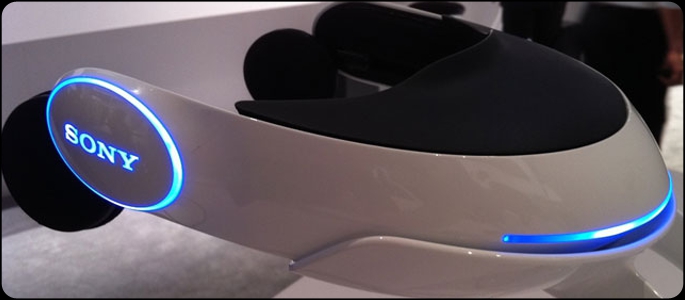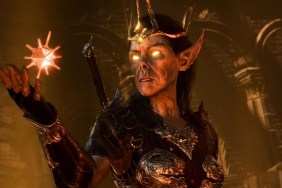It’s been a year since we last talked to Mick Hocking, Director of the Worldwide Studios 3D Team, about 3D, and a lot has changed, including people’s perception of the added dimension – but one thing has remained the same: Sony’s steadfast belief in the format as the viewing medium of the future. To see how well 3D has performed over the past year, what’s going on right now, and a look at the future of 3D – from head mounted displays to holographics, we chatted to Mick – who’s also the Vice President Studio Group for London Studio, Studio Liverpool, Evolution Studios and BigBig Studios – at the Develop Conference in Brighton.
To start off, you showed some figures on how you think 3D is going to grow over the next 5 years or so. Those figures were from 2009, are those still relevant?
Yeah, you have to take all these industry predictions at face value, but across the board, there still seems to be good confidence. 3D TV sales are growing, prices are coming down, prices of the glasses are coming down, and there’s all these new 3D devices – so there’s all these new reasons for people to go and buy a 3D TV, as well as games and films. I think we are pretty confident that the 3D market is going to continue to grow.
Has 3D adoption met your expectations over the past year?
Yeah, I think it’s as we expected it to be. Whenever you’ve got new technology launching there’s always loads of headlines, loads of hype that goes with it. But behind that there’s a reality of what’s actually going to happen, and yeah, 3D TV sales have increased steadily over the last 12 months and we think they are going to continue doing that.
If you look at the PS3’s 3D games, Sony’s first parties are mainly pushing the feature, with 3rd parties still slightly behind. Do you think that ratio will balance out a bit more as the console’s life continues?
There is actually quite a lot of 3rd parties, it’s about 50/50 between 1st and 3rd. I think it’s one of the things that we’re really trying to encourage: All third parties, whether they are small start-up teams or big established teams, get in touch with us and we’ll help them implement the 3D. We’re very, very keen to have 3D done well and it’s just a matter of educating the guys on the teams, helping them to shortcut the learning process, sharing the lessons that we’ve learnt, so that they can put great 3D out there.
So how many developers have contacted your 3D team?
There’s a lot, it’s all the time, from all around the world. We’ve done presentations to publishing partners, to developers etc. It’s pretty constant.
In your keynote, you talked about how you wanted smaller developers to make 3D games. But to make them, they need a 3D TV, won’t that be a problem if they have a small budget?
We’ve implemented 3D with people who don’t have a 3D TV. Some people would send us their code; we’d check it and send back screenshots saying ‘here is the problem’.
You say there are 50 million 3D-enabled PS3 out there, but can you tell how many are actually using the 3D capabilities?
Yeah, we don’t have exact figures at the moment but obviously that’s something we’re looking at at the moment. The first thing we concentrated on was getting as many 3D titles out there at a high quality, because the first thing that people ask themselves when they go and buy a 3D TV is ‘what am I going to watch on it?’ If they’ve got a PS3 then there’s a large library of movies and there’s a very large library of game, and they can look at their 3D photos.
One of the main advantages of 3D movies for film studios is that they can charge more if people watch the movie in an extra dimension. Have you ever considered having a tiered pricing structure for games?
I am not in charge of the pricing of products, but one of the points to make about 3D is the low investment it takes. It’s a maximum of around 2% with what we’ve seen so far, obviously it differs for different games, especially with different techniques of implementing 3D, but some of these games are down to half a percent of the development budget. If you look at any other feature in the game and ask yourself ‘how much did it cost compared to how much impact it could have?’ 3D’s really good bang for your buck, it’s a fantastic enhancement to a game, it’s a great thing we can deliver on PS3 natively because we are able to firmware upgrade the platform. Costs shouldn’t be a barrier to development studios.
Did you notice any bump in the sales of 3D Blu-ray movies when the update was released?
Again, I don’t really follow those figures on films.
Along with 3D, Sony has to push Move, Home, PSP and Vita – do you think this broad approach makes it hard for them to focus on 3D or other key features?
I think they are very used to focussing on a wide range of technologies, it’s such a huge company with so many things going on, it’s one of the really fun things about working inside Sony – we can go to Japan and talk to the electronics guys about ideas we’ve had in our R&D labs and they’ll go and make these things for us. It’s really exciting that I can be talking about things like the Dual-View Monitor and that simulview technique only 12 months ago, and now you can go and buy one fairly soon. It’s a really exciting thing working for Sony.
Has that been since the restructuring of Sony, one of their key goals was to promote synergy between their different arms?
It’s a truly global company, we have offices all over the world and many, many different departments. There’s a constant move to bring those together because the resources we can bring to bear are quite incredible. But like any big company, it’s got to get everybody to join together and focus on producing this great content or great hardware.
So how involved was PlayStation with the development of the PlayStation Monitor?
Very involved, that’s why we’ve branded it with the PlayStation name. We’re doing more and more of these kind of things now, we work very closely with our colleagues in Japan on all new hardware, and what’s great to see is that the hardware and the software sides of the business are integrating more and more and more. And that’s why we’re seeing great results like the PlayStation Vita – that’s the outcome of when software and hardware guys work together from the outset.
Do developers have to specifically develop their game for the PS Monitor for the simulview to work?
The screen will support any 3D or 2D signal, but if you want simulview then you have to render full screen for both players, and that’s a change to the software to do that.
And is that a big hassle, or a small change?
If you can already do 2 player head to head mode then, instead of drawing half a screen you’re drawing a full screen. It’s quite a simple change.
You also said that developers should try to avoid rapid changes of parallax and to ensure they don’t have window violations – that’s fine in cutscenes, but in games the user is in control. How do you still try to ensure that this doesn’t hamper quality?
When you’re playing the game, the speed at which you are moving is not the same as a cut – you tend to blend between, if you run past a window it’s the same as if you ran past a window in the real world: Your eyes are quite used to seeing that there is a parallax beyond the window and that there is a wall quite close to you. Where it’s cutting between different scenes, that works great in 2D, but the problem is that in 3D your eyes are trying to catch up with the change in depth. It can work, but we recommend you avoid it because it can become confusing to watch.
Who do you think is pushing 3D more, the consumers or companies like Sony?
I think both, I think Sony is producing a lot of great 3D hardware and content at the moment, and we’ve had a lot of interest and great pick-up in those items, because the technology is here that was never there before with 3D. And we’ve also got a large library of really good content already. People can invest in a 3D TV now with the satisfaction and comfort that there’s lots to watch and lots to play. We think 3D will be around for a good while yet.
Speaking of the future, you’ve got the head mounted display – how far away is that from being a reality for consumers?
You’ll have to talk to the guys making the head mounted display for that one. I don’t know, it’s in development at the moment, it’s very exciting for us. The same way with 3D in the past, the problems with VR [virtual reality] in the 1980s was that it was very expensive to produce any good effects, it was a big, heavy kit on your head, low resolution, laggy if you turned your head. Because technology has moved on so much, we can now deliver really high resolution OLED images with fantastic clarity, with very, very little lag and really immersive experiences. So, it’s very exciting what we might be able to do with head mounted displays.
You said that you tested out games on the display, were those PS3 games or just test minigames?
[Grins] I couldn’t possibly tell you I’m afraid, you’ll have to wait and see.
But it can technically support PS3 games?
Yes, it will take a HDMI signal, so you can play PS3 games, you can watch movies on it. But we’re doing R&D on it, but we’ll have to wait a little while before we can talk about it.
So, ten years down the line, what will people be using: 3D TVs, head mounted displays, holograms or something totally different?
It depends on what sort of experience they want, we can do pseudo-holographics with PSeye and PS3, make things come out into the room with you because we head-track where you are. With all these things, it’s about adding them to games where it really makes a difference. You really need to test these devices to discover what sort of games, what sort of genres, they add to and then focus on those.
Head-tracking really helps with 3D, is that something you’re pursuing – there is very little support for it in games?
I think there’s a big future in head-tracking, like I said you can use it for pseudo-holographics, you can make sure that the 3D is perfectly calculated for your viewing position. Of course, on head mounted displays you have the ability to do virtual reality immersive experiences. But yeah, head-tracking is going to be very useful for us in the future.
When we last talked you said that the 3DS was an interesting concept and that you wanted to see more of it – have you had a chance to check it out?
No, not at all actually. I can’t really comment on the 3DS itself, but I’ve not seen a great deal of it.
Why not?
We wouldn’t comment on other people’s hardware directly, it’s the same way we wouldn’t expect Nintendo to comment on ours.
When you cross-play WipEout HD between the Vita and the PS3, can the PS3 version output in 3D?
That’s a good question [laughs], I don’t think anyone’s ever asked that before… I don’t know, you’ve stopped me there.
But would there be any technical limitations?
In theory, no. Cross-play is simply getting the position of the ship onto both devices, so it should be technically possible.
Last year, we also talked about the difficulties of ensuring 3rd parties produce high quality 3D titles, are you happy with what they’ve developed over the past year?
Yeah, mostly, I think many of the 3rd parties have developed great solutions, but it’s not all perfect – that’s why, at the talk this year, I must have said “high quality” about 50 times. None of the developers want to make bad 3D, and, typically, if they’ve ended up with a bad 3D result, that means they didn’t know how to fix the problem or didn’t even know there was a problem while they were developing. That’s why, if they get in touch with us, we can really help out. Of course, it’s in our interest that all games on PS3 are of the best quality.
So, to teach developers do you do what you did today – purposely show what not to do with 3D, and give them a headache?
[Laughs] I try not to give them headaches, but we want to show them what to do. Typically what happens is that they send us a build and then we will either conference call them or see them and point out all the errors in 3D to them, and tell them how to fix it. And we find that they can produce great quality 3D.
The 360 kind of has 3D, but not really – do you think this gives a mixed message to consumers about what plays 3D?
I wouldn’t comment directly on Xbox, but I think our focus is just on providing the highest quality 3D experience, and PS3 is by far the most versatile 3D platform. Because we can firmware upgrade the system, it allows us to support fully 3D native gaming, 3D blu-ray, 3D photos and MP4s. That’s really our focus at the moment.
Are you trying to expand the 3D multimedia capabilities?
Oh yeah, sure. PlayStation 3 was always seen, from it’s outset, as an extremely powerful multimedia device, and it’s also an extremely good – I would say the best – gaming device as well. You can download PlayMemories from PSN, do fantastic things with 3D photos – zoom into 3D photos, which is great – there’s also a lot of 3D content on the internet, places like YouTube, a lot of 3D MP4s out there, which you can download and play, and of course you can play full HD 3D movies.
Could you bring the technology behind the PlayStation Monitor to other Sony products?
We may well see it on other Sony products, I don’t know but it would be great, yeah.
The screen is 24” – is there a technical limitation to the size?
The issue with that technique – because you are drawing two separate images on the full screen – is one of ghosting, it’s of panel performance. So as long as the panel can refresh quickly enough with the smallest amount of persistence it works fine, so that’s really the limitation of it. Panels are getting higher spec all the time, so it will become possible on different screens in the future.
And in the future, will it be possible to have that, but in 3D?
So then you’ve got refresh, your challenge then is going to be – if you’re offering 60 frames per second, 60 frames for each eye, times 4, and making sure there’s no bleed through on both… So again, it’s technically possible, but how much light are you going to get to your eyes in that time? You have to think every second you are dividing up the amount of light that can physically travel to your eye into smaller and smaller chunks. It is possible – you could do 4 or 8 players in theory – but you are starting to play with the limitations of the laws of physics.
While 3D is growing, the market is still small – do you think adding 3D to a game is a unique selling point?
Yeah, because I think it can really enhance the gaming experience. It has different effects on different types of games. It can make some games, like our game Tumble, more intuitive – it feels right in 3D, you pull an object back and it comes at you in 3D, you push it forward, it goes into the screen. In racing games, you can get more accurate at racing, I am a big petrol head and love racing, so a tenth of my lap time is worth the investment as far as I’m concerned. For things like FPSes and action games, we can offer a great sense of immersion – it’s a little bit like adding full surround audio to the experience: Why to people do that? Because they want to be drawn further into the gaming world. 3D can give you that great sense of immersion.
There’s Move-only games, would you ever consider 3D-only games?
I think lots of designers are thinking about it, but: 1) There needs to be a market for a 3D-only game, 2) Someone to invest into it and make it and 3) We don’t have an idea of what a 3D-only game would be like because we’re so used to designing in 2D, and people are just getting used to what’s possible in 3D, what the paradigm actually means. So, in the future, we might see somebody come up with an idea that only works if you’re viewing in 3D.
When Sony goes out to a publisher to try and convince them to add certain features, what do you think is more important to them, Move or 3D?
Both [laughs], and Vita.
But does that make it more difficult – Microsoft has less, so they can focus on it more?
It’s one of the big strengths of Sony, we can produce a great handheld device, we can continually upgrade the PS3, we can produce more accessible input devices like Move, and there’s a whole host of stuff going on to the future, and even more exciting devices. I think we’re offering customers really amazing experiences in both the mobile and living room environments, and long may it continue.
You pretty much manage all the racing studios in the UK, what are their plans for PlayStation Vita?
[Grins] I can’t talk about things that haven’t been announced, I’m afraid, but there’s cool stuff coming.
So if you’re a racing fan, should you get a Vita?
I would hope that the Vita is going to please all fans of all genres of games.








